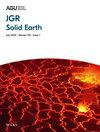南海混响映射了地幔过渡带广泛的俯冲板块停滞
IF 4.1
2区 地球科学
Q1 GEOCHEMISTRY & GEOPHYSICS
引用次数: 0
摘要
地幔过渡带(MTZ)是一个岩石结构和组成发生重大变化的区域。在地震中观测到的矿物学相变为半不连续特征,对上下地幔之间的热化学通量起到了半渗透性屏障的作用。它们在一定程度上控制着全球地幔环流模式。然而,了解区域尺度的对流过程依赖于高质量的地震测量,以及在观测方法的覆盖范围和分辨率方面的改进。在这里,我们使用新的大型全球sc混响数据集对MTZ不连续进行了全面分析。使用数据驱动和机器学习方法编译和处理数据集,突出了快速数据分析自动化方法的潜在能力。我们的地图揭示了410和660 km不连续深度的显著地形变化,从而揭示了MTZ厚度,并为现有MTZ地图提供了补充的空间几何。这些结果与MTZ厚度与地震波速度的一阶相关性一致,并进一步表明在所有数据覆盖区域中地形的额外较小尺度横向变化。我们将我们的观测结果与矿物学模型相结合,得出了MTZ的新的热和成分模型。我们的模型显示了最近俯冲和玄武岩聚集的位置之间的相关性,以及热点和高温区域之间的相关性。温度和成分在变率上都受短长度尺度模式的支配,表明MTZ内普遍存在和持续的非均质性。综上所述,这些观测结果证明了在MTZ和MTZ内部存在着广泛而长期的物质停滞。本文章由计算机程序翻译,如有差异,请以英文原文为准。
ScS Reverberations Map Widespread Subducted Slab Stagnation in the Mantle Transition Zone
Earth's mantle transition zone (MTZ) is a region of substantial transformations in the structure and composition of rocks. The mineralogical phase changes, observed seismically as semi‐discontinuous features, act as a semi‐permeable barrier to thermochemical flux between the upper and lower mantle. They partly control global mantle circulation patterns. However, understanding regional‐scale convection processes relies on high‐quality seismic measurements with improvements in observational approaches in terms of coverage and resolution. Here, we perform a comprehensive analysis of the MTZ discontinuities using new large global data sets of ScS reverberations. The data sets are compiled and processed using data‐driven and machine learning methodologies, highlighting the prospective capacity of automated approaches for rapid data analysis. Our maps reveal significant topography variations in the 410 and 660 km discontinuity depths, and hence MTZ thickness, and provide complementary spatial geometry to existing MTZ maps. These results are consistent with first order correlation of MTZ thickness with seismic wavespeed, and further indicate additional smaller scale lateral variation in topography across all regions of data coverage. We integrate our observations with mineralogical modeling to derive new thermal and compositional models of the MTZ. Our models display a correlation between locations of recent subduction and basalt accumulation, and between hotspots and regions of high temperature. Both temperature and composition are dominated by short‐length scale patterns in their variability, indicating ubiquitous and persistent heterogeneities within the MTZ. Together, these observations evidence widespread and long‐term stagnation of material at and within the MTZ.
求助全文
通过发布文献求助,成功后即可免费获取论文全文。
去求助
来源期刊

Journal of Geophysical Research: Solid Earth
Earth and Planetary Sciences-Geophysics
CiteScore
7.50
自引率
15.40%
发文量
559
期刊介绍:
The Journal of Geophysical Research: Solid Earth serves as the premier publication for the breadth of solid Earth geophysics including (in alphabetical order): electromagnetic methods; exploration geophysics; geodesy and gravity; geodynamics, rheology, and plate kinematics; geomagnetism and paleomagnetism; hydrogeophysics; Instruments, techniques, and models; solid Earth interactions with the cryosphere, atmosphere, oceans, and climate; marine geology and geophysics; natural and anthropogenic hazards; near surface geophysics; petrology, geochemistry, and mineralogy; planet Earth physics and chemistry; rock mechanics and deformation; seismology; tectonophysics; and volcanology.
JGR: Solid Earth has long distinguished itself as the venue for publication of Research Articles backed solidly by data and as well as presenting theoretical and numerical developments with broad applications. Research Articles published in JGR: Solid Earth have had long-term impacts in their fields.
JGR: Solid Earth provides a venue for special issues and special themes based on conferences, workshops, and community initiatives. JGR: Solid Earth also publishes Commentaries on research and emerging trends in the field; these are commissioned by the editors, and suggestion are welcome.
 求助内容:
求助内容: 应助结果提醒方式:
应助结果提醒方式:


